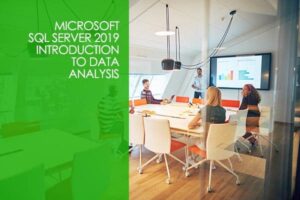Course Overview

Course objectives
This course will also explore how to implement proper security standards and policies across the Power BI spectrum including datasets and groups. The course will also discuss how to manage and deploy reports and dashboards for sharing and content distribution. This course will show how to build paginated reports within the Power BI service and publish them to a workspace for inclusion within Power BI. Power BI is a member of the Power Platform.
Modules
Module 1: Query Tools
- 1.1 Course Introduction
- 1.2 Intro to Management Studio
- 1.3 Intro to command-line query tools
Module 2: Introduction to T-SQL Querying
- 2.1 Introducing T-SQL
- 2.2 Understanding Sets
- 2.3 Understanding the Logical Order of Operations in SELECT statements
Module 3: Basic SELECT Queries
- 3.1 Writing Simple SELECT Statements
- 3.2 Eliminate Duplicates with DISTINCT
- 3.3 Using Column and Table Aliases
- 3.4 Write Simple CASE Expressions
Module 4: Querying Multiple Tables
- 4.1 Understanding Joins
- 4.2 Querying with Inner Joins
- 4.3 Querying with Outer Joins
- 4.4 Querying with Cross Joins and Self Joins
Module 5: Sorting and Filtering Data
- 5.1 Sorting Data
- 5.2 Filtering Data with Predicates
- 5.3 Filtering with the TOP and OFFSET-FETCH
- 5.4 Working with Unknown Values
Module 6: Introduction to Business Intelligence and Data Modeling
- 6.1 Introduction to Business Intelligence
- 6.2 The Microsoft Business Intelligence Platform
- 6.3 Exploring a Data Warehouse
- 6.4 Exploring a Data Model
Module 7: Prepare Data
- 7.1 Introduction to Power BI
- 7.2 Get data from various data sources
- 7.3 Preview source data
Module 8: Clean, Transform, and Load Data
- 8.1 Data Transformation Intro
- 8.2 Transformation Example 1
- 8.3 Transformation Example 2
- 8.4 Transformation Example 3
- 8.5 Transformation Example 4
- 8.6 Transformation Example 5
- 8.7 Transformation Example 6
Module 9: Design a Data Model
- 9.1 Introduction to Data Modeling
- 9.2 Model Relationships
- 9.3 Table Configuration
- 9.4 Model interface
- 9.5 Quick Measures
- 9.6 Many-to-many relationships
- 9.7 Row-level security
Module 10: Create Model Calculations using DAX
- 10.1 DAX context
- 10.2 Calculated Tables
- 10.3 Calculated Columns
- 10.4 Managing Date Tables
- 10.5 Measures
- 10.6 Filter Manipulation
- 10.7 Time Intelligence
Module 11: Create Reports
- 11.1 Basic Report Creation
- 11.2 Example Page 1
- 11.3 Example Page 2
- 11.4 Example Page 3
- 11.5 Report Publishing
- 11.6 Enhancing Reports
- 11.7 Drill-Through Pages
- 11.8 Conditional Formatting
- 11.9 Buttons and Bookmarks
Module 12: Create Dashboards
- 12.1 Dashboard Basics
- 12.2 Real Time Dashboards
- 12.3 Enhanced Dashboards
Module 13: Create Paginated Reports
- 13.1 Introduction to Power BI Report Builder
- 13.2 Report Layouts
- 13.3 Report Data
- 13.4 Report Tables
Module 14: Perform Advanced Analytics
- 14.1 Introduction to Advanced Analytics
- 14.2 Scatter Chart
- 14.3 Forecast
- 14.4 Decomposition Tree
- 14.5 Key Influencers
Module 15: Create and Manage Workspaces
- 15.1 Introduction to Workspaces
- 15.2 Working with Workspaces and the Portal
Module 16: Create Power App Visuals
- 16.1 Introduction to Power Apps Visual
- 16.2 Creating the App
- 16.3 Basic Power Apps Concepts
- 16.4 Refreshing the Report
Module 17: nalysis Services and Power BI
- 17.1 Introduction to Analysis Services
- 17.2 Connecting with Multidimensional Models
- 17.3 Premium Workspaces and Analysis Services
- 17.4 Course Wrap Up
Modes of Learning
- Flashcards: Remember the “read and guess” games we used to play back then? Here’s to enhance what you learned. How does it work? A statement will be written on a flashcard, and you’ll need to guess the answer. Then flip it over to see if you answered it correctly. The cards continue, each with a random statement from the course that you took previously.
- Scatter: “Make Everything Disappear.” Turn the screen white and vanish it all but this time testing your knowledge and your time being monitored. Find the best match and click your way toward success. This brain teaser might give you a hard time! But education combined with games adds an element of fun to it.
- Learn: Here’s another. Read and choose the right answer. A game designed on a Multiple-Choice pattern. This kind of exercise boosts your confidence. When one option seems to be correct, you choose the other only for it to be the right option. The right option will welcome another statement, but don’t sweat! You are still learning.
- Speller: This fun-packed game is unique in its own way. Hear the term carefully and type it out on your screen. You think you are a pro at learning spellings of tricky terms. Test yourself out with this game. Could you hear it properly? If you could, were you able to write it?
We have found our students doing absolutely great by showcasing their certificates. Grab that certificate of yours before someone else does and get that recognition you deserve.
You best learn when you see it. Our easy-to-understand video content is in place for you. Watch the studying content and grasp all the concepts easily. With so many lectures and 3000+ hours of video content, find what suits your needs. These educational videos are designed to sharpen your experience with your training content. Our easy-to-understand video content is in place for you. Watch the studying content and grasp all the concepts easily.
In contrast to other e-learning services, our labs will let you exercise what you analyze in a real environment with a lot to choose from. This layout mirrors the traditional study room format which ensures you will recognize exactly the way to set up, manage and troubleshoot any environment.
Being a successful IT professional involves more than knowing key terms and concepts. You need to be able to “apply” your knowledge to real-world situations. At EZDA we quote, “Learn it to pertain to it.” So, why spend money buying the equipment when we got you all covered?

